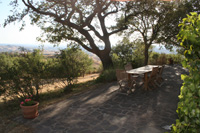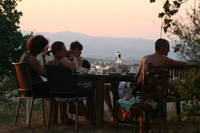|
| The Terre di Siena, as the countryside around Siena is known, are a stunning backdrop to the territory's artistic and cultural wonders, with dozens of roads to follow, each itinerary offering new ways of discovering Siena's natural beauty as you seek out its best known masterpieces. The Crete Senesi is known for its soft hills and many consider it to be the most beautiful part of this region. Driving from Siena to Montalcino, the capital of Brunello wines, the views are unforgettable and stops at the Sacred Art Museum at Asciano and the stunning Abbey of Monteoliveto Maggiore are absolute musts.[1] Buonconvento, Castelnuovo Berardenga, Monteroni d'Arbia, Rapolano Terme, San Giovanni d'Asso, Siena, Sinalunga and Trequanda are situated in the surroundings of Asciano and are within an hour's drive from Podere Santa Pia. The road which leads from Castiglioncello Bandini to Asciano and Buenconvento, passing first through Castello Porrona, Montalcino and the Abbazia di Monte Oliveto Maggiore, is breathtaking. Podere Santa Pia is a holiday house in the southern part of Tuscany. |
||||
| Asciano lies in the foothills of the Crete, in the upper valley of the Ombrone river between Siena and the Valdichiana. Asciano is a typical medieval borough, surrounded by 14th century walls. Magnificent roads set out from Asciano: the historic Lauretana towards Siena, Via di Rapolano and the splendid dirt road of Monte Sante Marie. Having Etruscan and Roman origins, Asciano was purchased by the Sienese in 1285 and surrounded by walls in 1351. Asciano still preserves its medieval character despite the town-planning schemes of the fascist period and extensive building after the Second World War. The Romanesque collegiate church of Sant’ Agata (11th cent.) in travertine, is its most outstanding architectural feature. Adorned with decorative elements of the Lombard type and flanked by a 13th century crenellated campanile, it has an aisle less nave with a truss roof. Adjoining it is the Museo d’Arte Sacra where works by painters of the Sienese school of the 14th and 15th centuries are exhibited. The Museo archeologico contains finds from the excavation of a group of chamber tombs in the nearby cemetery of Poggio Pinci. In 1991 a museum devoted to the artist Amos Cassioli was founded as the result of a gift from his family. A walk through the center is worthwhile, but what really makes the trip are the views from the road to Siena once left this nice town. |
||||
The Saint Agata Basilica
|
||||
| |
||||
Collegiata di Sant'Agata (Asciano) [2]
|
||||
The Saint Agata Basilica is one of the best preserved and of the most beautiful Romanic churches in the territory of Siena. The basilica, dedicated to the well-known martyr from Catania, is the main church of Asciano since 1029, when it prevailed for important over the ancient Parish of Saint Ippolito. The structure that you can see now comes from different building stages which date back to a long period , from the XII and the XIX century. The church, made up of a nave with an apsidal transept covered with cross vaults, ends with a semicircular apse and it is enclosed by a characteristic and high dome, covered with an octagonal lantern, surmounted by a fired-brick lantern, which is supported by some pilasters situated above the presbytery. And if the tripartite front, decorated with pointed arches, testify how this imposing building has been created during the period of transition between the Romanesque and the Gothic time, the beautiful tower which is next to the central part, brings back to evident Lombard models. Among the decorative arrays which occurred in succession during the centuries, there are two sixteenth-century-frescos of the Sodoma’s studio. The abundant wealth of its paintings by well-known artists was gathered, for safety reasons, in the adjacent Museum of Sacred Art, institued in 1952 (formerly the Oratory of Santa Croce). In the church remain the large fresco of the Madonna Enthroned that is attributed to Girolamo Sodoma, the 14 Stations of the Via Crucis made of polychrome terracotta of quite good workmanship (the work a local workshop), several 17th-century paintings by Sienese masters, and also the baptismal font in perfect Romanesque style from the very old parish church of Sant'Ippolito, carved in a block of monolithic travertine. Behind the high altar there is also a splendid wooden-crucifix of the XV century. |
|
|||
| |
||||
Collegiata di Sant'Agata, cupola (Asciano) [3]
|
||||
|
|
||||
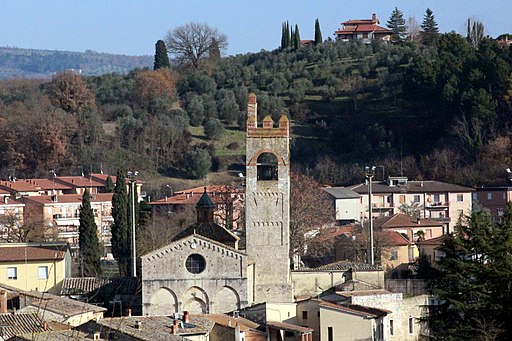 |
 |
 |
||
Asciano, base of the festival
|
|
Deserto di Accona | Crete Senesi (laghi tra Castello Leonina e Vescona, Crete Senesi, Asciano)
|
|
 |
 |
 |
||
|
||||
 |
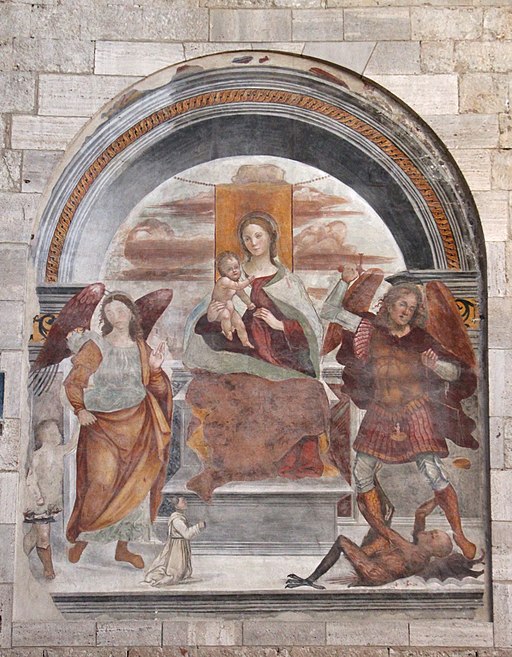 |
 |
||
|
||||
 |
||||
Basilica di Sant'Agata (Asciano), interiore [1]
|
||||
| Museo Palazzo Corboli | Museo d'Arte Sacra e Archeologico |
||||
Palazzo Corboli belonged to the noble Sienese Bandinelli family, whose coat of arms recurs throughout the painted decoration of the building, which features two fourteenth-century allegorical fresco cycles in the Aristotle Room and the Room of the Seasons, attributed to Cristoforo di Bindoccio and Meo di Pero.
|
||||
 |
||||
Sala di Aristotele con affreschi attr. a Cristoforo di Bindoccio e Meo di Pero, XIV sec., museo di Palazzo Corboli, Asciano [4]
|
||||
| Palazzo Corboli, a magnificent palace dating from the 12th century, has been refurbished and houses the Museo d'Arte Sacra e Archeologico. The collection of Etruscan artifacts is displayed well, but the real highlight is the collection of lesser-known 13th- and 14th-century paintings from the Sienese school. The collection include a series of paintings by the most famous Sienese artists from the 14th to the 16yth Century such as Segna di Buonaventura, Ambrogio Lorenzetti (Saint Michael slaying the dragon), Maestro dell'Osservanza, Matteo di Giovanni, Rutilio Manetti, Bernardino Mei e Francesco Nasin. Among the works are also worthy of note some sculptures by Giovanni Pisano and Francesco Valdambrino. The archeological section is housed in several rooms on the second and third floors, displaying finds that document the presence of Etruscan settlements in the Upper Ombrone Valley. Museo d'Arte Sacra e Archeologico | Address: Corso Matteotti, 122 - 53041 Asciano | Tel. 0577 719524 After a complex restoration campaign, the museum fitted out to the internal of Palazzo Corboli opened in 2000 to present newly to the public works exposed before in the Etruscan museum and sacral art museum. In the second floor, it’s possible to admire the archeological material discovered in the last fifthy years in the surrounded areas, as proof of old events of the Ombrone High Valley. Among these there are to sign Poggione necropolis diggings, with ivories and buccheri, funeral elements of Molinello barrow with rare examples of archaic sculpture and metallic objects, and the famous Poggio Pinci tomb rebuilding dated between V and I century B.C. in travertine stone urn and tufa, red pictures ceramics, bronze vases, mirrors and clocks. The sacral art section begins with a series of works which represents the political and religious local history, until when in middle ages Asciano became a very important economic place which attracted the rich sienese families. Here we can find, as a painted revelation, a series of paintings realized by the best sienese artists from XIV to XVI century: Segna di Buonaventura, Ambrogio Lorenzetti, il Maestro dell’Osservanza, Matteo di Giovanni, Rutilio Manetti, Bernardino Mei e Francesco Nasini, but also precious wooden sculptures such as the works of Giovanni Pisano and Francesco Di Valdambrino. Some rooms of the Palace are very interesting, they are paintings about political-ethic subject coming from the second middle of XIV century. |
|
|||
The Oratory of Santa Croce is a sacred building in the Basilica square, beside the Romanesque church of Saint Agata. It has an homogeneous seventeenth-century furnishings and a decorative array all centred on the theme of the Christ’s Passion: the lunettes, which were frescoed in 1660 by Francesco Nasini and the structure of Mei and Deifobo Burbarini. The altar piece by Mei with the Crucifix with the Virgin Mary and Saint Francesco and Saint Agata, was replaced, between the end of the XVIII and the beginning of the XIX century, with a “Deposition” from the studio of Rutilio Manetti. On the sides of the altar there are still two small canvas where Deifobo Burbarini represented the “Mourning about Christ’s death” and a “Resurrection”; underneath the canvas there are two ciborium, maybe of the XVI century. Until some years ago it was the seat of the Museum of Sacred Art. |
|
|||
The church of the Madonna of the Garden in Camparboli (more properly Church of the Nativity of the Virgin Mary) is a sacred building situated in Camparboli, in Asciano. The building has an ancient origin and it was a plebeian church until the XVIII, assigned to the care of an hermit ; the building, to testify the constant veneration of the image of the Madonna with the Christ Child, probably frescoed on the main altar in the XV century, has had several rearrangements from the XV to the XVII century, when the three altars of the church was built and provided with canvas, which today are lost. |
||||
The chapel of the Saints Fabiano and Sebastiano is a sacred building situated in the resort Camparboli near Asciano. It is the most imposing road-tabernacle of the whole territory of Asciano and it still shows, in the front, the traces of a plugged arch, which is a sign of the original function of public oratory, underlined also by the presence, under the Assumption of the Virgin Mary, a fresco attributed to Benvenuto di Giovanni (1436-1518), of Saint Fabiano and Saint Sebastiano, who are the protectors against the plague and the epidemics, and the three saints, S. Girolamo, S.Rocco and S. Lucia, painted inside false aediculas, maybe by the young Girolamo del Pacchia, on the wall on the right of the high altar. Benvenuto di Giovanni di Meo del Guasta was the son of a bricklayer and lived and worked in or near Siena all his life. He is first recorded working as an artist in 1453 when he was painting in the Siena Baptistery, probably with il Vecchietta, who may have been his teacher. In his early years he was also influenced by Matteo di Giovanni, Francesco di Giorgio and Neroccio de' Landi. His style changed considerably in the 1480s. In a tax return of 1465, Benvenuto declared himself to be without property or relations and to be living near the baptistery. The following year he married Jacopa di Tommaso da Cetona with whom he had seven children. They owned a vineyard, and Benvenuto served at least two terms in public office. Among his extant works, nine are signed and dated altarpieces, four are identifiable through documents and many others can be attributed to him on stylistic grounds. Their dates span 43 years, and they include panel paintings, frescoes, manuscripts and designs for the decorative pavement of Siena Cathedral. Girolamo di Benvenuto was a pupil and longtime collaborator of his father, Benvenuto di Giovanni. He asserted himself as an independent painter on 1498, completing the Assumption now on display in the museum at Montalcino. His secular work is particularly important, especially his birth trays (Hercules at the Crossroad, Galleria Franchetti, Ca' d'Oro, Venice). |
||||
Sant'Ippolito Parish Church. The Pieve di Sant'Ippolito was situated outside the village, with an original basilica plant. The church now belongs to a private owner and is reduced to a single nave. The main altar is decorated with a fresco with the Madonna col Bambino in trono and the Saints Ippolito and Cassiano.
|
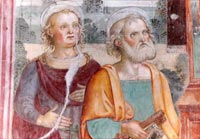 Frescoe in the parish of Saint Ippolito |
|||
| One of the Asciano attractions that you shouldn’t miss is the Chiesa di San Francesco. It, along with its large convent, was built in the 13th century over the remains of a medieval bridge house. The façade is a simple stone façade with mullioned windows. The bell tower is partly made of bricks and partly made of stone. The church contains one nave and its ceiling is composed of exposed wooden beams. Between the 17th and 18th centuries, the church underwent massive renovations. Baroque style altars were added, frescoed niches were closed, as were some of the large Gothic windows. The last restoration, started at the end of the XX century, has allowed to recover some of the wall-paintings. The overall style of the original church was Romanesque and Gothic and the date of its construction is confirmed by the remains of frescoes dating to the 1200s, found on the walls of the nave and on the central chapel. There is only a nave and on the main altar there is a beautiful altarpiece by Della Robbia. There is a precious marble stoup of XIV century. Frescoes maybe by local painter Giovanni d’Asciano and others cover the inner walls. These frescoes mainly depict scenes from the life of Saint Francis. In Palestra chapel there is an interesting painting portraying the martyrdom of Saint Marguerite.
|
||||
|
||||
|
||||
The Monastery of Saint Cristoforo in Rofeno is a sacred building in Badia a Rofeno. It is mentioned since 1031. While the church keeps the Cistercian architectonic typologies, the annexed cloister shows the last, visible eighteent-century interventions, made by the Olivetans, who, since 1375 had taken the whole complex. Behind the main altar, the monks put a big altar piece by Ambrogio Lorenzetti with Saint Michele and the Benedictine Saints, maybe fruit of an assembly at the beginning of the XVI century, to which dates back the carpentry which frames it and which was probably carved by the friar Raffaello from Reggio, at the same time as the making of the wooden ciborium, which is kept, together with the polyptych, in the Museum of the Sacred Art of Asciano.
|
||||
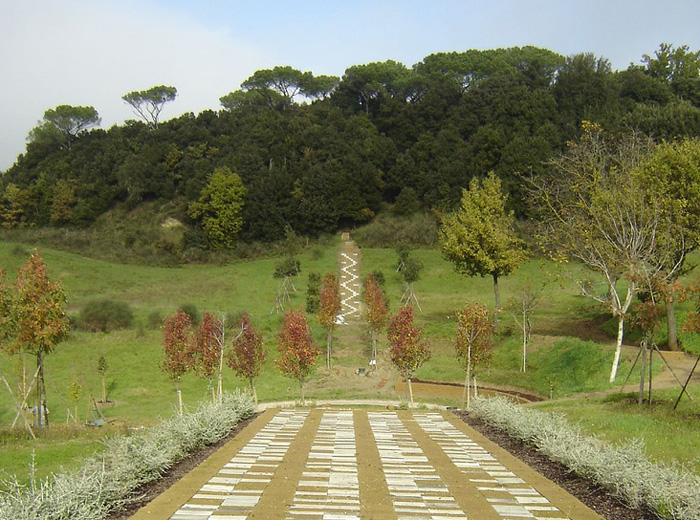 |
||
San Giovanni d'Asso | Il Bosco della Ragnaia |
||
| The road from Montalcino to Radicofani runs through San Giovanni d’Asso, a small hamlet nestled comfortably in the hills of this beautiful landscape. The ancient romanesque church of San Giovanni Battista is near to the castle, while in the lower part of the village lies the most important church in the area, the beautiful San Pietro in Villore, built in the 11th and 12th centuries, and which is now surrounded by many cypresses. Among the numerous celebrations periodically taking place in San Giovanni d'Asso we remind the Exhibit of the White Truffle held yearly on November, during which it is possible to admire the famous typical white truffles. Il Bosco della Ragnaia on the outskirts of San Giovanni d’Asso, is a modern garden created by artist and philosopher Sheppard Craige that includes elements of formal spaces, modern art, and wooded areas (boschi).
|
||
Youtube | Il bosco della Ragnaia - Sheppard Craige
|
||
| Buonconvento is an ancient settlement south of Siena, along the Via Cassia, where the Arbia and Ombrone rivers meet in the heart of the magical hills of
the Crete Senesi.
The first residential settlements in the area of Buonconvento probably go back to the Etruscan and Roman Ages. Despite this historical data about the foundation of the village, its development starts on the 12th century, when the village already had a great importance as a place where the trading activities took place, promoted this latter by the closeness to the two rivers and to its position on the Via Francigena, one of Europe's major routes in the Middle Ages. Among the most important monuments to see in Buonconvento we point out here the Parrocchiale di San Pietro, the Oratorio di San Sebastiano, the Palazzo Ricci, hosting today the Holy Art Museum of the valley of Arbia. Inside the walls, the village is crossed from north to south by Via Soccini, the most aristocratic street in Buonconvento, with several palazzi. Palazzo Podestarile, with the 14th-century rectangular civic tower and the two Gothic arches in the façade, the Palazzo Comunale, or Town Hall, with its attractive brick front, and the imposing Palazzo Taja, built entirely in brick, and across from it is Palazzo Borghesi, built in the 14th century, which belonged to an old Sienese family whose coat of arms can be seen on the splendid façade. The important art works by Sienese artists such as Duccio di Boninsegna, Sano di Pietro, Andrea di Bartoio and Lucca di Tommè that were originally located in the Parrocchiale di San Pietro, are now in the Val d'Arbia Museum of Sacred Art, in the 19th-century Palazzo Ricci-Socini which is further down the Via Soccini. [read more] Museo d'Arte Sacra della Val d'Arbia | Address: Via Soccini, 18 - Buonconvento Tel.:0577 807181 WWW: www.museisenesi.org Weekly market in Buonconvento is on Saturday (Piazza Antonio Gramsci 8:00-13:00). |
|
|||||||||||||||||||||||||||||||||||||||||||
The Castle of Gallico, with its five towers in stone and red bricks, is a wonderful example of a fortified farm. Its imposing structure rises solitary on the tableland of the Crete in the Commune of Asciano, not far from the village of Montecalvoli. The sienese family of Tolomei bought the castle of Gallicoin 1319 and ,towards the end of the century, it enlarged the already existent tower for keeping there the products of the land. Later it became a castle-grancia. The Griffolis, rich merchants of silk from Montepulciano, bought it in the first half of the XV century and the sienese republic obliged them to keep there a garrison of soldiers to defend this important strategic outpost. Passed through different owners, towards the end of the XVIII century, it was given to the Hospital of Santa Maria della Scala of Siena. Today,the castle has been carefully restored and enclosed, so that, unfortunately, now you can admire it only from far off. |
||||||||||||||||||||||||||||||||||||||||||||
Chiusure on the top of which survived the rearranged rests of an ancient castle which is part of Saint Angelo in Luco. It is situated on a high slope which, in the past, was covered with woods, where the Monastery of Monte Oliveto Maggiore was erected, into the village of Chiusure, about 1 km far. The antiquity of this settlement is testified by the fact that its church of Saint Angelo in Luco, at the beginning of the VIII century, was the object of a dispute among the bishops of Siena and those of Arezzo. It is also mentioned in the approval bill of the Congregation of the Olivetans, and of their major monastery, where it is said that it was founded in the district of Saint Michele in Luco’s parish. From some ancient sienese memoirs, we know that Antonio di Meo Tolomei bought Chiusure in 1333. It seems superfluous to add that the founder of the Congregation of Monte Oliveto belonged to the same sienese family of Tolomei and that the hillock of Acona, where the first hermitage was erected, was wooded. |
||||||||||||||||||||||||||||||||||||||||||||
The comune Trequanda comprises the three villages of Trequanda, Petroio and Castelmuzio. Trequanda rises to the eastern border of the Crete Senesi territory. The origin of Trequanda is unknown, as is the etymology of its name. The Commune comprises the three villages of Trequanda, Petroio and Castelmuzio. Trequanda itself offers fascinating churches such as the parish church of Saint Stefano a Cennaro. A third of the village is taken up by the castle Cacciaconti and its various annexes, including a small ornamental garden. The majestic stone tower, partly rebuilt after the war, dominates the entire complex from the north-east and is a singular witness to the original fortified castle structure. The Parish church of. SS.Pietro e Andrea, founded in the 1200s, has an ashlar facade of light and dark stone with a resulting effect of colour little known in this region. Inside is a fresco of the Trasfiguration by Sodoma and a triptych by Giovanni di Paolo with Madonna and Child. Cultural events |
||||||||||||||||||||||||||||||||||||||||||||
| Montalceto, or Mount Alceto, a castle in the Ombrone’s valley which is now destroyed, of which it rests only the tower on the top of the homonymous mount in the middle of a holm oak’ wood. The church of the Saints Sabino and Alberto of Montalceto, in the XII century, was an hermitage under the parish of Asciano, to which it was confirmed, together with other churches of this area, by a bill of the Pope Alessandro III. The hermitage became famous after that the blessed Alberto, an hermit from Camaldoli, lived here in penitence and died in 1150. The baths of Montalceto are situated on the homonymous mount in the sienese Val d’Ombrone, about a mile away from the road Regio Lauretana, which from Siena leads to Asciano, going through Montalceto in Val di Chiana. These sources belong to the class of the thermal acidulous waters, of which the hills of the valleys of Ombrone, Orcia and Merse are rich. They apparently spring from the cuts of porous travertine which lays on the tuff and on the shell-shaped marl, mentioned in the article of the Community of Asciano. The highest part of the hill of Montalceto, from the sides of which spring the thermal waters, is surrounded by rocks of calcareous magnesia and veined with banks of siliceous breccias, seams of stone-flint and cliffs of a calcareous stone become cellulose, from the spaces left empty by the gas which developed there. Petroio (13th century) is built on a curious circular plan and is one of the best brick castles in the region. A few kilometres to the northeast is the Abbadia a Sicile, a beautiful Italian old village. |
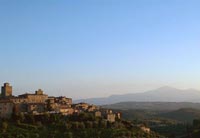 Petroio |
|||||||||||||||||||||||||||||||||||||||||||
|
||||||||||||||||||||||||||||||||||||||||||||
|
||||||||||||||||||||||||||||||||||||||||||||
| |
 |
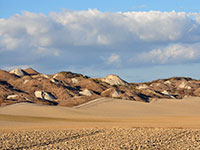 |
||||||||||||||||||||||||||||||||||||||||||
Driving from Montisi to San Giovanni d'Asso today morning, looking to Monte Amiata from the countryside
|
Trekking in the Crete senesi (Asciano)
|
Circular walk Biancane Leonina
|
||||||||||||||||||||||||||||||||||||||||||
Via Lauretana Antica In this area there are some farms about 4 kilometres from Asciano, along the Via Lauretana Antica, being in a raised position as regards to the surrounding valleys. Turning the eyes southwards, you can enjoy a splendid view over the village of Asciano. |
||||||||||||||||||||||||||||||||||||||||||||
|
||||||||||||||||||||||||||||||||||||||||||||
|
||||||||||||||||||||||||||||||||||||||||||||
|
||||||||||||||||||||||||||||||||||||||||||||

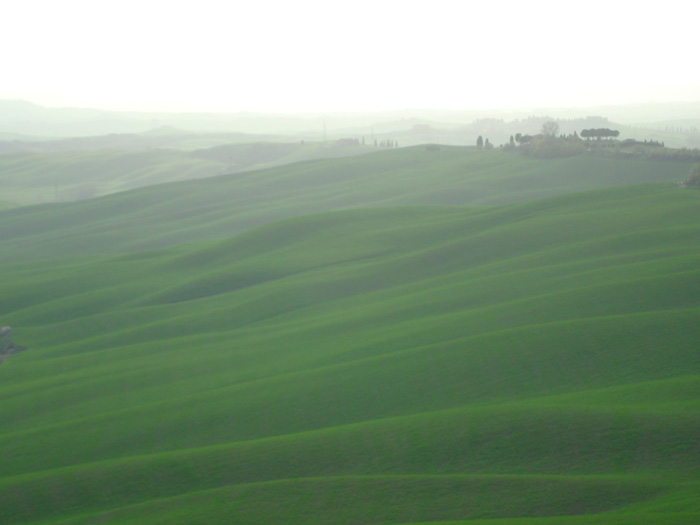
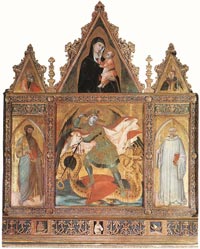
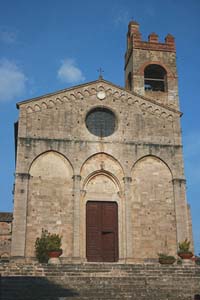
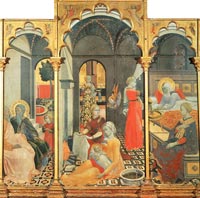
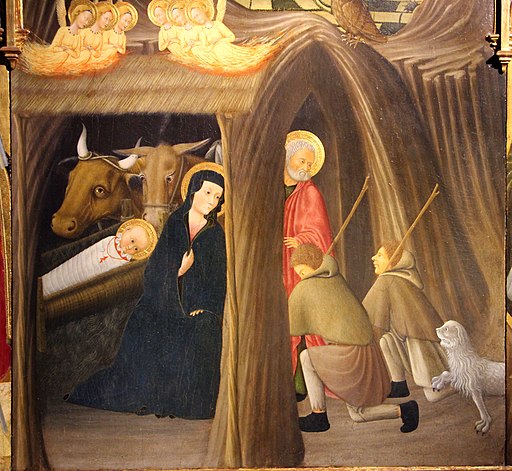
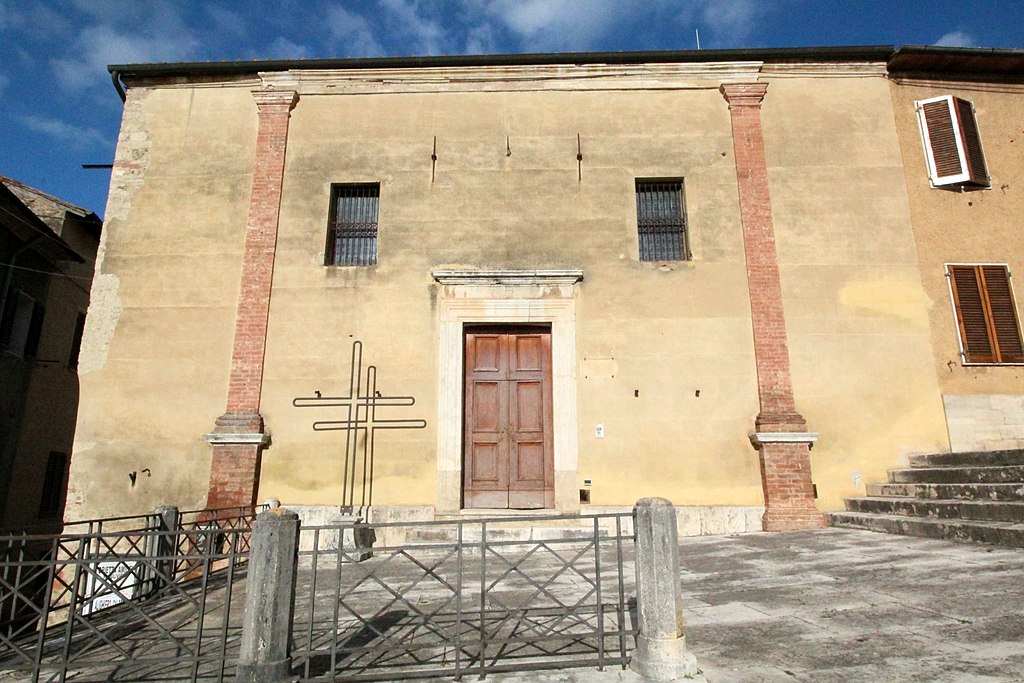
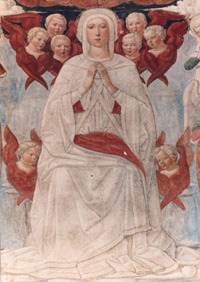
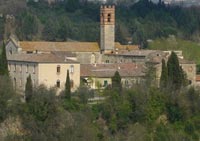
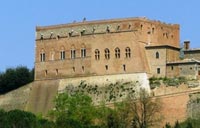
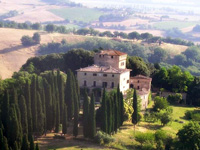 Castelnuovo Tancredi
Castelnuovo Tancredi 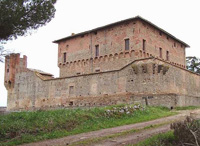 Bibbiano castle
Bibbiano castle 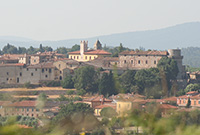 Trequanda
Trequanda
